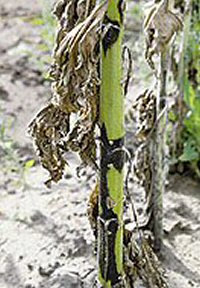Phoma In Sunflowers
Infected sunflowers are weakened, produce smaller heads, and are susceptible to lodging.

Host Crops
Sunflowers
Biology
This soil-borne fungus overwinters in infected debris and is spread by splashing rain and by insects. Adult stem weevils feeding on the leaves cause leaf lesions whereas weevil larvae spread the fungus as they tunnel through the stem. Disease transmission through contaminated seed is minor. Yield losses are variable, but in conjunction with stem weevil infestation, can become quite significant.
Symptoms Of Damage
Phoma black stem is characterized by large, jet-black lesions on the stem, up to five centimetres (two inches) in length. The fungus also produces lesions on the leaves, on the back of the head, at the crown or base of the stalk, and occasionally, on the leaf petioles.
Lesions usually originate at the base of the leaf petiole and spread to form spots with more or less definite margins. Under favorable conditions, the leaves wilt, petioles turn black, and the stem lesions expand to form a large, shiny, black patch. Small circular fruiting bodies of the fungus, produced on the surface of the stem, are visible with a hand lens.
Scouting Techniques
Phoma infections occur throughout the growing season but they are usually more pronounced after flowering and noticed when the stem lesions become obvious later in the summer.
Economic Thresholds
None available
Control Tips
- Failure to rotate fields amplifies problems with phoma (and other diseases). A four-year rotation to other crops will minimize the concentration of phoma within the soil.
- Although some hybrids may be more tolerant than others, none are resistant.
- Controlling high populations of stem weevils may help to reduce disease transmission.

